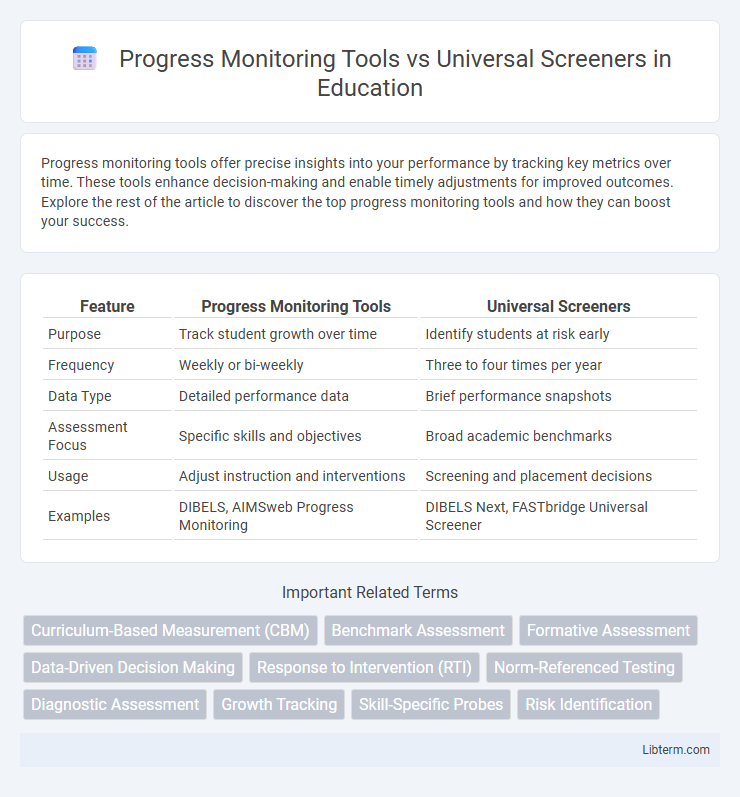Progress monitoring tools offer precise insights into your performance by tracking key metrics over time. These tools enhance decision-making and enable timely adjustments for improved outcomes. Explore the rest of the article to discover the top progress monitoring tools and how they can boost your success.
Table of Comparison
| Feature | Progress Monitoring Tools | Universal Screeners |
|---|---|---|
| Purpose | Track student growth over time | Identify students at risk early |
| Frequency | Weekly or bi-weekly | Three to four times per year |
| Data Type | Detailed performance data | Brief performance snapshots |
| Assessment Focus | Specific skills and objectives | Broad academic benchmarks |
| Usage | Adjust instruction and interventions | Screening and placement decisions |
| Examples | DIBELS, AIMSweb Progress Monitoring | DIBELS Next, FASTbridge Universal Screener |
Introduction to Progress Monitoring Tools and Universal Screeners
Progress monitoring tools are designed to regularly assess student performance and growth over time, providing detailed data to guide instruction and interventions. Universal screeners are brief assessments administered to all students within a specific grade or population to identify those at risk for academic difficulties. Both tools play a crucial role in response to intervention (RTI) frameworks by informing educators about student needs and progress, but progress monitoring tools focus on continuous tracking while universal screeners emphasize early identification.
Defining Progress Monitoring Tools
Progress monitoring tools are specialized assessments used regularly to track a student's academic performance and growth over time, providing data-driven insights to inform instruction. Unlike universal screeners, which are brief and administered to all students to identify those at risk, progress monitoring tools offer detailed, ongoing measurements to gauge the effectiveness of interventions. These tools often include curriculum-based measurements (CBMs) and are essential for tailoring educational strategies and ensuring targeted support.
What Are Universal Screeners?
Universal screeners are brief assessments used to identify students at risk for academic difficulties by measuring essential skills across reading, math, or behavior domains. These tools provide educators with data to guide early interventions and prevent learning challenges from escalating. Universal screeners differ from progress monitoring tools, which track individual student growth over time to evaluate the effectiveness of instruction and interventions.
Key Differences Between Progress Monitoring Tools and Universal Screeners
Progress monitoring tools provide frequent, individualized data to track students' academic growth and adjust instruction, while universal screeners identify at-risk students through brief, early assessments administered to all students. Progress monitoring involves continuous measurement over time, focusing on student-specific performance, whereas universal screeners offer a snapshot to guide initial intervention decisions. The key difference lies in the frequency and purpose: progress monitoring supports ongoing instructional adjustments, and universal screeners aid in early identification and placement.
Purposes and Goals: Screening vs. Ongoing Assessment
Progress monitoring tools provide ongoing assessment by tracking student performance frequently to inform instruction and measure growth over time, ensuring timely interventions. Universal screeners serve the initial purpose of identifying students at risk for learning difficulties through brief, comprehensive assessments administered to all students. Together, these tools support a balanced approach to early identification and continuous evaluation in educational settings.
Examples of Common Universal Screeners
Common universal screeners include the DIBELS (Dynamic Indicators of Basic Early Literacy Skills), AIMSweb, and the STAR Early Literacy assessments, which are designed to quickly identify students at risk for reading difficulties. These screeners provide standardized benchmarks across grade levels and are typically administered to all students to ensure early detection of learning challenges. Data from universal screeners help educators make informed decisions about interventions and resource allocation prior to more frequent progress monitoring.
Popular Progress Monitoring Tools in Education
Popular progress monitoring tools in education such as AIMSweb, DIBELS (Dynamic Indicators of Basic Early Literacy Skills), and STAR Assessments provide frequent, data-driven insights to track student growth in reading, math, and language skills. These tools enable educators to identify learning gaps early and adjust instruction to meet individual student needs effectively. Unlike universal screeners, which are typically administered at set times for broad identification, progress monitoring tools are used regularly to measure ongoing student performance and intervention outcomes.
Benefits of Using Both Assessment Methods
Using both progress monitoring tools and universal screeners provides a comprehensive approach to student assessment by combining frequent, targeted data with broad, initial identification. Progress monitoring tools deliver ongoing insights into individual student growth, enabling timely instructional adjustments, while universal screeners efficiently identify students at risk for learning difficulties across an entire population. Integrating both methods enhances early intervention accuracy, supports personalized learning plans, and improves overall educational outcomes by ensuring consistent progress tracking alongside early detection.
Challenges and Considerations for Implementation
Progress monitoring tools require frequent data collection and analysis, posing challenges in ensuring timely and accurate implementation across diverse student populations. Universal screeners, designed for early identification of learning difficulties, demand careful selection to balance sensitivity and specificity, avoiding false positives or negatives. Schools must consider resource availability, training requirements, and data management systems to effectively integrate both tools within multi-tiered systems of support (MTSS).
Selecting the Right Tool for Educational Success
Selecting the right tool for educational success involves understanding the distinct roles of progress monitoring tools and universal screeners: progress monitoring tools provide frequent, detailed assessments that track individual student growth over time, while universal screeners offer broad evaluations to identify students at risk and guide initial interventions. Effective educational outcomes depend on integrating both tools to inform instruction, tailor interventions, and quickly adjust strategies based on data-driven insights. Choosing tools aligned with curricular goals, student needs, and assessment frequency ensures accurate tracking and supports targeted support for improved learning achievement.
Progress Monitoring Tools Infographic

 libterm.com
libterm.com